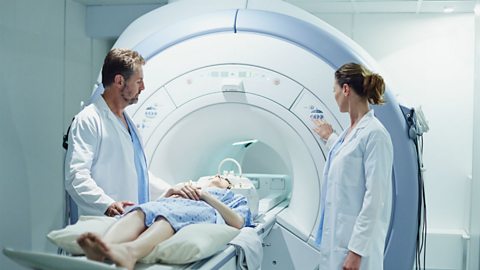Investigating the brain - Higher
Carrying out research into the functions of the brain is becoming increasingly important. More and more people are living longer and dementiaAn illness in which memory is lost because parts of the brain can no longer function normally. is becoming more common. The more that scientists understand about how the brain functions, the more likely they are to be able to develop treatments for brain conditions, including dementia.
Although our current understanding of brain function is still quite limited, modern science has allowed scientists to discover how some of the different parts of the brain function. neuroscientistsScientists that study nerves and how nervous system diseases occur and can be treated. have mapped various regions of the brain to particular functions by:
- studying patients with brain damage
- electrically stimulating different parts of the brain
- using functional magnetic resonance imaging (MRIMagnetic Resonance Imaging - A computer that can scan the human body using magnetic fields and radio waves, used in medicine.) scanning techniques
Brain damage
A well-documented example of brain damage is of Phineas Gage, who in 1848 had a serious accident whilst laying railway tracks and an iron rod went through his skull.
Phineas survived the accident, but it was documented that his personality changed following it. It was noted that he lost his inhibitions socially and emotionally.
Doctors realised the changes in Phineas were due to the damage in the particular parts of the brain that the iron rod had passed through. This important case allowed scientists to examine the effect of the injuries on his brain activity.
Electrical stimulation
Scientists have stimulated different parts of the brain with a weak electrical current and asked patients to describe what they experienced. This is a non-invasiveA medical procedure that does not involve cutting the skin. approach to studying the brain.
If the motor area of the brain is stimulated, the patient makes an involuntary movement. If the visual area is stimulated, they may see a flash of colour. electroencephalogram (EEG)An image of the electrical signals in the brain. can be created and studied, to observe the electrical activity in the brain.
MRI brain scans
Modern imaging methods such as functional MRI (Magnetic Resonance Imaging) scans use strong magnetic fields and radio waves to study brain function. This technological development has been very powerful in helping neuroscientists develop their theories about how the brain works. Patients are asked to perform various tasks and, by looking at the scan, scientists can see which parts of the brain are active when the task is carried out. This helps to link particular areas of the brain with the function of that part.

Problems with brain studies
Our ability to investigate brain function and develop scientific explanations still remains limited. There are many risks associated with brain studies and treatments of brain diseases, as well as ethical concerns.
Brain surgery may be needed to remove a tumour or excess fluid such as blood. All surgery carries a level of risk, but due to the complexity and delicacy of the brain, investigating and treating brain disorders can be very difficult. If surgery is undergone more damage or side-effects may be created, which could affect the patient's quality of life. Serious considerations about the risks involved against the benefits need to be undertaken first.
Obtaining consent from brain-damaged patients is a controversial issue. These patients could be very useful in helping scientists to link areas of the brain with certain functions. However, it is unethical to carry out experiments on a patient who is not deemed capable of making clear decisions about whether or not they want to take part in scientific research.
More guides on this topic
- How do substances get into, out of and around our bodies?
- Why do we need to maintain a constant internal environment?
- What role do hormones play in human reproduction? - OCR 21st Century
- What can happen when organs & control systems stop working?
- Sample exam questions - the human body - staying alive